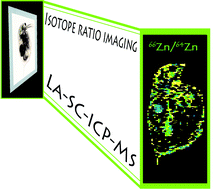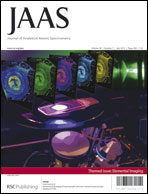In this paper, the possibilities of LA-single collector-ICP-mass spectrometry for obtaining isotope ratio images of thin sections of Daphnia magna specimens exposed to isotopically enriched Zn tracers were evaluated. Zn was selected considering its importance in ecotoxicological studies. All aspects of the analytical methodology deployed were carefully studied and optimized for obtaining the best isotope ratio precision and accuracy. The development of this methodological approach consisted of: (i) evaluation of the performance of two different medium mass resolution exit slits, a conventional one providing a mass resolution of m/Δm ≈ 4000 and triangular shaped peaks, and another (wider) one, offering a lower mass resolution (m/Δm ≈ 2000), but providing enhanced ion transmission and flat-topped peaks; (ii) the use of a wet plasma for improving plasma robustness; (iii) thorough optimization of the ablation conditions (such as laser spot size, repetition rate, scan speed and laser fluence) and data acquisition parameters (such as scan mode, the number of nuclides monitored, mass window, the number of samples per peak and dwell times); and (iv) adequate data treatment including the use of the moving average of 5 individual values. With the methodology developed, isotope ratio images with 30 micrometer spatial resolution scale were obtained for exposed and unexposed Daphnia magna individuals. The typical overall uncertainty of the measurements was approximately 5% RSD for the 66Zn/64Zn and 68Zn/64Zn ratios, which can be considered as satisfactory taking into account that the amount of Zn present per 30 μm × 30 μm pixel only reached a few picograms in the most favourable cases (giving rise to 10 000–20 000 counts per s for 64Zn). These results open the possibility for tracer studies with stable isotopes to be carried out using single collector instrumentation, a much more widespread analytical technique than multi-collector ICP-MS.

You have access to this article
 Please wait while we load your content...
Something went wrong. Try again?
Please wait while we load your content...
Something went wrong. Try again?


 Please wait while we load your content...
Please wait while we load your content...